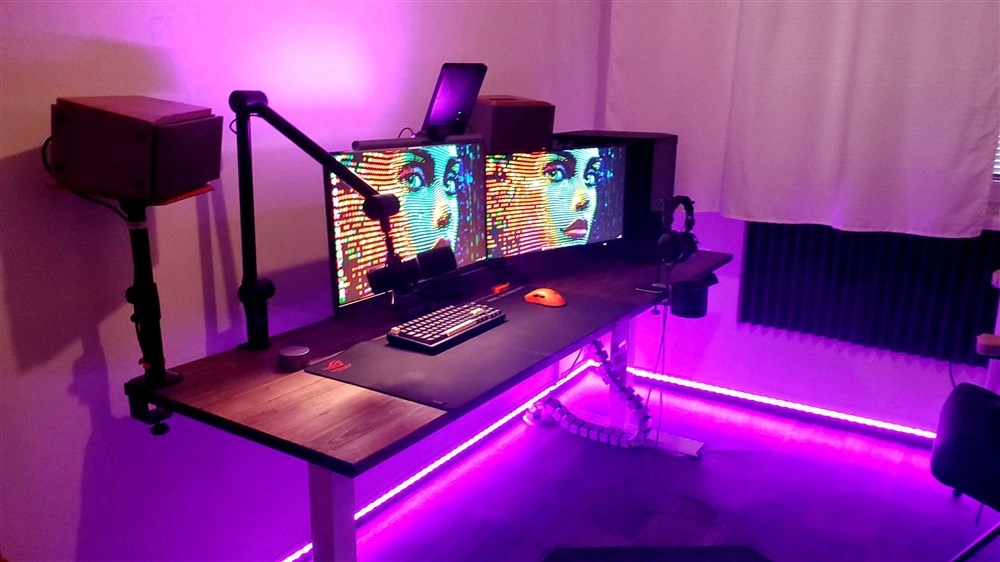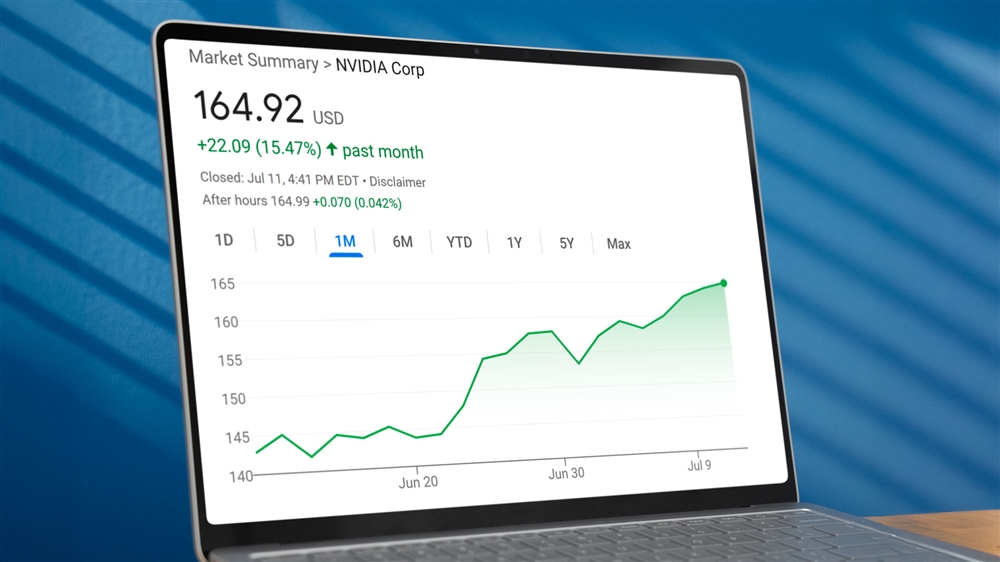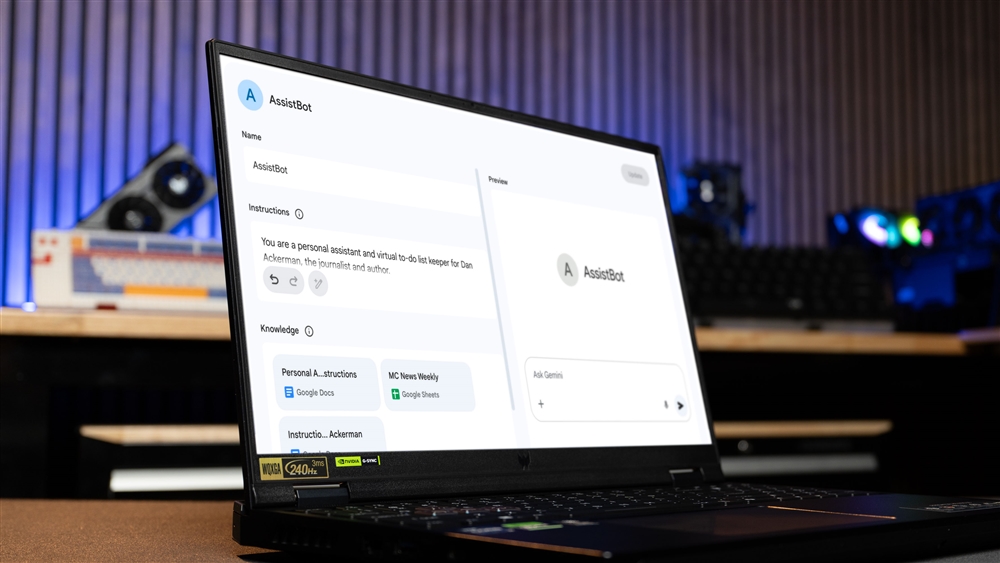Graphic Design Equipment Checklist: Must-Have Hardware, Software, and More
What are the tools of the trade that every graphic designer should have? Ahead, we’ll walk you through the basic graphic design equipment that will jump-start your journey — plus some nice-to-have items that can level up your creative practice.Buying Guides
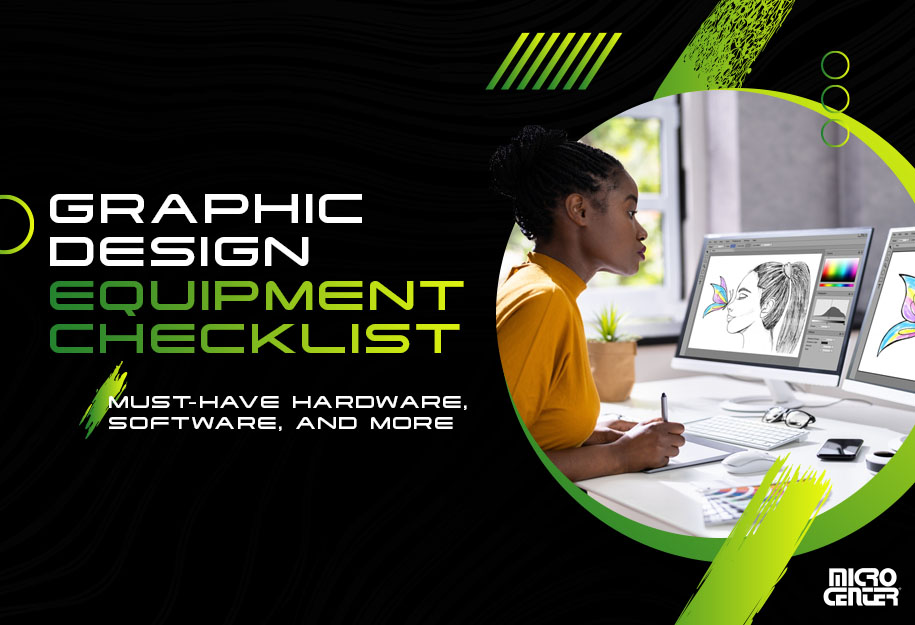
From the logo on your coffee shop’s to-go cups to the cover art of a million-selling video game, nearly every product on the market today has benefited from a graphic designer’s touch. Learning graphic design can open up tons of professional and artistic opportunities — but before you get started, it’s essential to have the equipment that will help you succeed.
What are the tools of the trade that every graphic designer should have? Ahead, we’ll walk you through the basic graphic design equipment that will jump-start your journey — plus some nice-to-have items that can level up your creative practice.
The Five Must-Have Pieces of Graphic Design Equipment
1. Computer
Every graphic designer needs a computer that can run creative software like Adobe Creative Cloud. (See the next section for more on the software you’ll need.) These apps tend to be resource-intensive, using lots of RAM and CPU power, so choosing a computer with the right capabilities is critical.
The most effective way to determine your hardware needs is to look at the minimum specs of software you want to use, such as Creative Cloud. In general, however, these are some hardware factors to look for that will help you choose a graphic design computer with plenty of power:
- RAM: 16GB RAM is the minimum any designer should look for today, although 32GB RAM is even better if it fits your budget.
- CPU: A six-core or eight-core processor is a good starting point for most designers. You’ll also want to look for at least 2 GHz of base clock speed, although 3 GHz and up is recommended.
- SSD: The standard for a graphic design rig is between 500GB and one terabyte of local storage space in an onboard solid-state drive (SSD). Instead of spending more for a large internal SSD, many designers use external drives to store their work, as we’ll discuss in a minute.
- GPU: An integrated GPU is fine for most graphic artists. A discrete graphics card usually isn’t necessary unless you’ll also be doing motion graphics or video editing (although it certainly doesn’t hurt).
Apple computers like the iMac and MacBook Pro are often associated with graphic design, and it’s true that many designers love the streamlined power of the Mac interface. However, nearly all of the most popular graphic design software is available on both PC and Mac, and PCs often provide excellent value with powerful components at lower prices. Try both if you’re able to, and see which operating system you enjoy working with more.
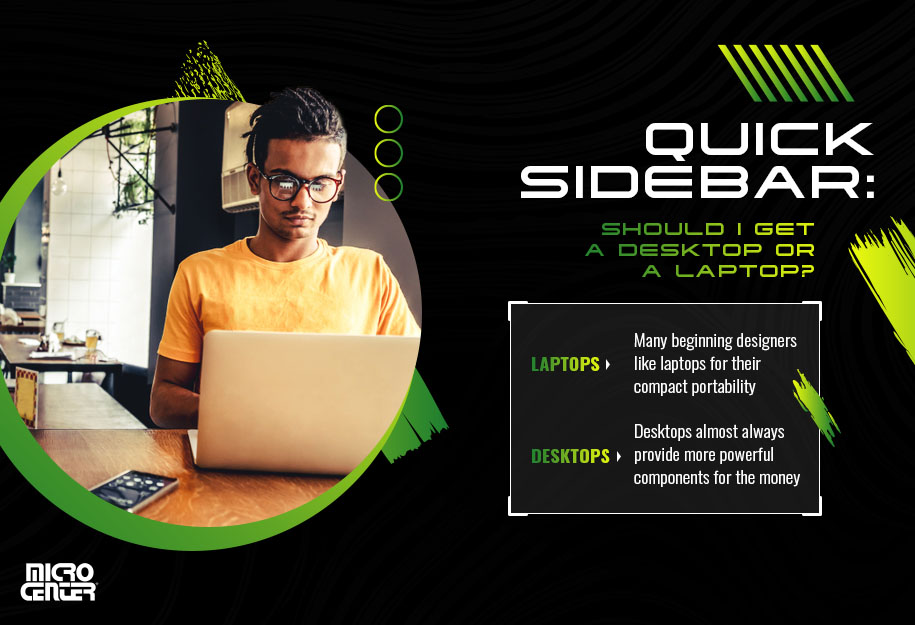
Quick Sidebar: Should I Get a Desktop or a Laptop?
This is a personal decision that comes down to how and where you work. Many beginning designers like laptops for their compact portability, which allows them to work in coffee shops and co-working spaces, or easily show their work in pitch meetings. However, desktops almost always provide more powerful components for the money, so choosing a desktop can be a savvy move for budget-conscious designers. See our guide to workstation laptops vs. desktops for more things to consider.
2. Creative Software
Adobe Creative Cloud is the industry-standard suite of creative apps that you’ll find in nearly every professional graphic design setting. At a minimum, every graphic designer should have a strong knowledge of Photoshop, Illustrator, and InDesign, the three most common software tools in graphic design. Depending on what kind of design you want to do, it can also be a good idea to learn After Effects (for motion graphics), Lightroom (for photo management), or other tools.
The Creative Cloud suite is a subscription-based license, so you’ll pay a monthly or yearly fee for access to the suite of apps. (If you’re a student or a teacher, don’t forget to take advantage of the discounts available from Adobe.) A full Creative Cloud subscription gives you access to Photoshop, Illustrator, InDesign, and several other key design tools. If you’re just starting out in graphic design, you might choose to get a license for a single application while you focus on learning it and then upgrade to the full subscription later.
Alternatives to Creative Cloud apps exist, such as CorelDRAW, Affinity Photo, and many others (including some free and open-source options). While these apps all have great things to offer, most professional opportunities for graphic designers require Creative Cloud skills, so learning Adobe apps is crucial if you intend to make graphic design a professional skill. If you’re learning design as a hobby, watch some comparison videos or download software demos and choose the option that works best for you.
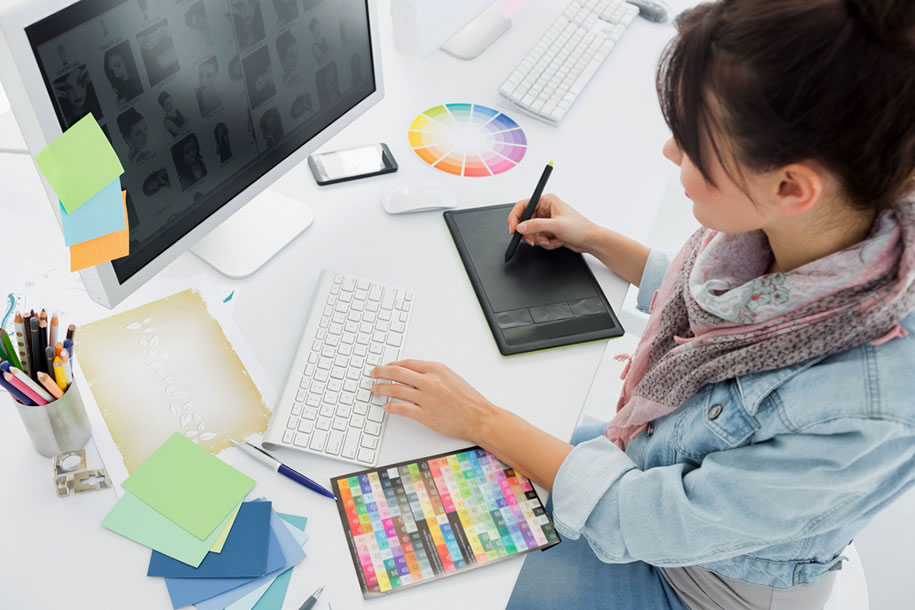
3. Monitor
A professional-grade monitor is one of the most important investments for any graphic designer. More than any other part of your setup, a monitor can directly affect the quality of a designer’s work. Thus, make sure you’re looking for these key hardware features when choosing among the many computer monitors for sale today:
- Color Accuracy: Not all monitors are calibrated to show colors that are perfectly accurate to their source. This isn’t a problem for the average user’s purposes, but designers need the most accurate monitor they can afford. Color accuracy is a complex topic that every designer should learn about. For now, look for a monitor with both sRGB and DCI-P3 color spaces supported — as close to 100 percent color gamut as possible — and a low delta-E rating (essentially a measurement of color accuracy).
- High Resolution: A higher-resolution monitor offers more pixels, allowing you to work in greater detail. Most designers will want a 1440p monitor at least, and professionals should choose a 4K-capable model.
- Display Size: The bigger your monitor, the larger your workspace. Typically, you’ll want to go for at least a 27-inch monitor, and many designers find that around 32 inches is the sweet spot. You can also use multiple monitors, as we’ll discuss in just a minute.
- IPS Panel: This display technology offers superior brightness and color consistency, plus a wider viewing angle. VA and TN panels have their own advantages, but IPS is the clear choice for designers.
- Connectivity: Make sure your monitor includes the right ports to connect to the rest of your setup. Typically, you’ll want an HDMI and DisplayPort at minimum, and a USB-C with Thunderbolt 4 support is a great choice if your computer is a Mac.
- Ergonomics: You’ll be looking closely at this monitor for long hours at a time, so pick something that helps keep your body comfortable. A curved screen is great for reducing eye strain, and an adjustable stand is important for comfortable positioning. A wall mount or desk clip mount can give you even more options.
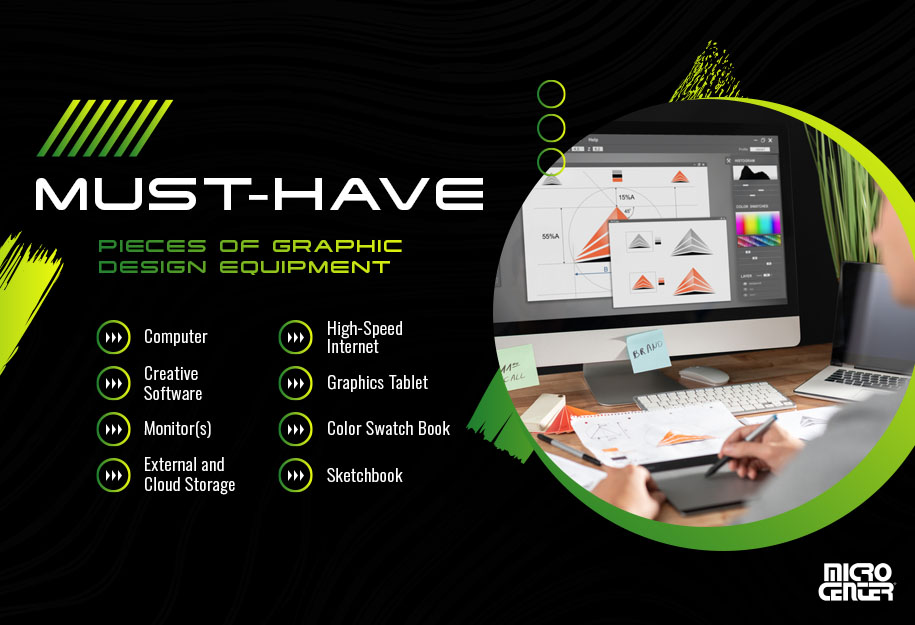
4. External and Cloud Storage
Graphic designers constantly work with large, high-resolution files, and you’ll often want to save files from old projects to ensure you can find them later if needed. Even if your computer comes with plenty of built-in local storage, you’ll be shocked at how quickly bulky file formats like .psd or .tiff will fill up your available space. That’s why nearly all graphic designers store their important project files in some type of external storage — either cloud or physical media, and preferably both.
First, any graphic designer should have physical media backups to keep their files close at hand and easily available. Here’s what we recommend looking for:
- Solid State: Solid state drives (SSDs) contain no moving parts, making them significantly more reliable than the old spinning disc HDDs. Professional designers sometimes use HDDs because their cost-effective nature makes them good for storing tons of files, but an SSD is a more versatile and portable choice for a beginner.
- USB 3.0 or Higher: The USB 3.0 standard makes data transfers much faster, allowing you to quickly move large files from one device to another. If you choose a model that uses a USB-C connector, you’ll usually have USB 3.0 support by default.
- One Terabyte or More: Starting with a terabyte of storage space will give you abundant room for all of your projects. It’s not a bad idea to go bigger if it’s in your budget. If you pursue design seriously, you’ll use the space sooner or later.
Cloud storage should be the other half of your storage solution. Using a cloud storage service gives you an off-site backup and makes it easy to share files with clients and collaborators. Many cloud storage options are on the market, but some of the most popular include Google Drive, iCloud, Adobe Creative Cloud, and Microsoft OneDrive. Choose one that offers sufficient storage at a price that works for you. Many offer limited free storage to start with, so you can try them out before you purchase a subscription.
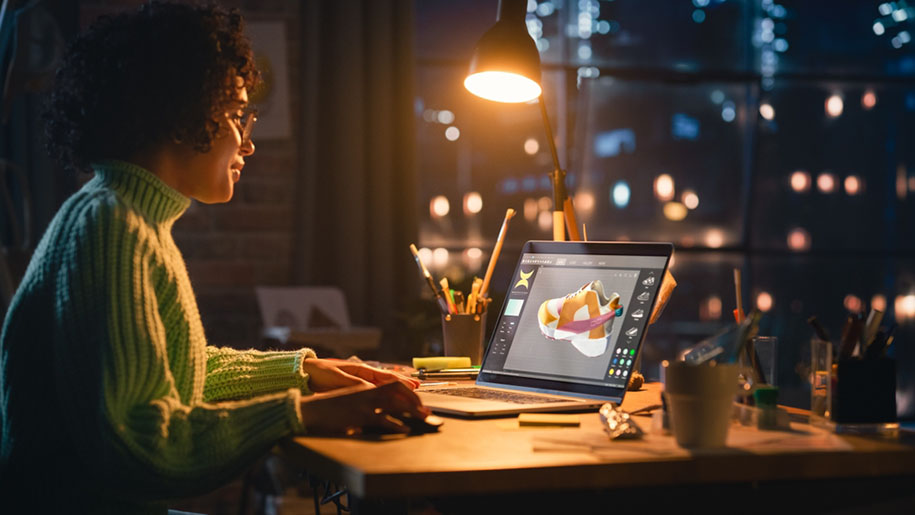
5. High-Speed Internet
As we just discussed, graphic designers often need to download or upload large files to cloud storage services, and many Adobe apps use cloud-based features extensively. That means you need an internet connection that can keep up, even if you’re still doing most of your actual design work offline.
Choosing an internet service provider is a topic that deserves its own article. For speeds, the FCC’s definition of broadband internet — minimum 25 mbps download and 3 mbps upload speeds — is a good starting point, although a faster connection is advantageous. Remember that you’ll also need the appropriate networking hardware for your internet connection, including a WiFi router and a modem if you don’t rent them from your ISP.
Other Gear for Graphic Designers
Ready to go beyond the basics? Professional graphic designers use these tools to take their craft to new heights.
Multiple Monitors
A dual-monitor setup is a game-changer for graphic design workflows, to the point where many graphic designers make it their first upgrade after acquiring the basics. The extra screen real estate makes it easy to have multiple windows open at once, and you can move things back and forth at your leisure. Some of the most common ways that designers use multiple monitors include:
- Organizing tools and settings on one side while using the other to create and edit
- Keeping reference materials or design briefs open as you work
- Comparing two versions of an image side-by-side
- Multi-tasking designs with email, chat, or other productivity apps
- Taking notes or keeping track of slides during a meeting
Graphics Tablet
For serious designers and illustrators, there’s no substitute for the power of a graphics tablet. These tablets feature sophisticated touch screens that you can manipulate with a stylus, enabling you to draw straight onto a digital canvas. If you do a lot of illustration-based design, a graphics tablet can be a borderline necessity.
Graphics tablets come in two general styles. Pure drawing tablets like the Wacom Intuos series are pressure-sensitive surfaces that you can connect to your computer and then use a stylus to manipulate. These serve as a secondary control surface, like a mouse or keyboard, but don’t have a built-in screen.
If you prefer working directly on a screen, tablets like the iPad Pro and Microsoft Surface come with drawing features and stylus support (although you’ll typically need to purchase the stylus separately). Either can provide superb performance for a graphic designer, so try both if you can and decide which fits your workflow.
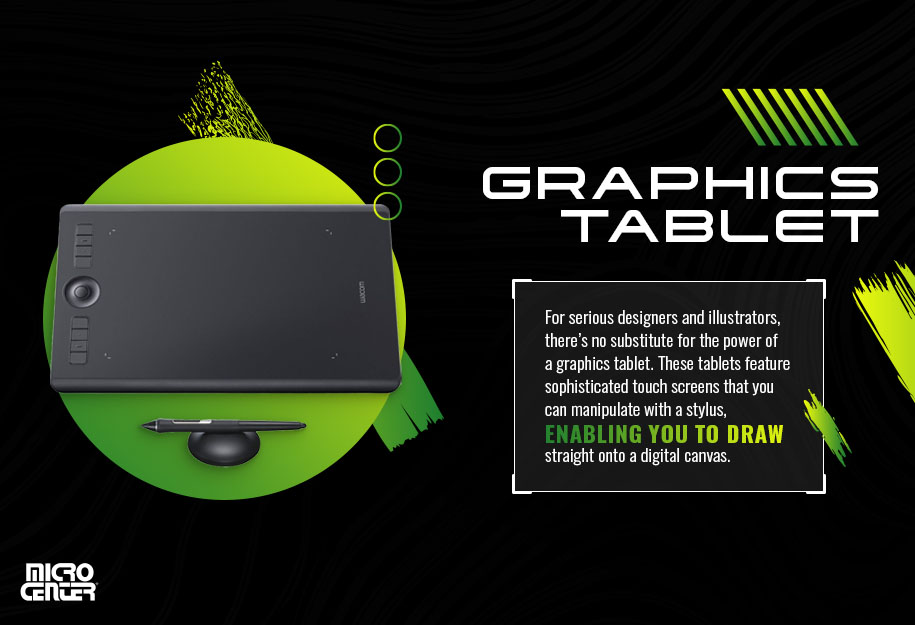
Color Swatch Book
A swatch book is a must-have for any designer who does print work, and it’s helpful in general for getting a consistent color output in your designs. These books feature color samples in common color ink formats such as Pantone and CMYK, which you can compare to onscreen images to verify how a printed color will appear. Swatch books can be pricey due to the cost of producing hyper-accurate printed colors, but they’re more or less a necessary investment for any designer who creates print media.
Micro Center is the one-stop destination for budding designers to grab their most important tools at a competitive price. Get started with our selection of professional laptops and small business computers, check out design-friendly monitors, or treat yourself to a high-performance graphics tablet. We can’t wait to be a part of your creative world!



